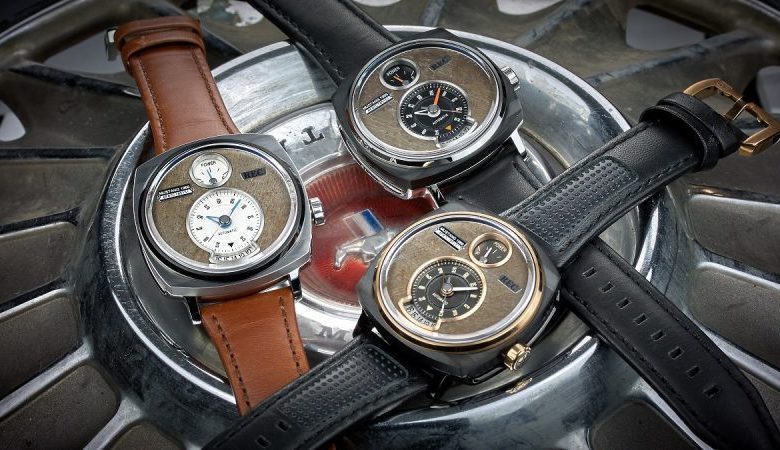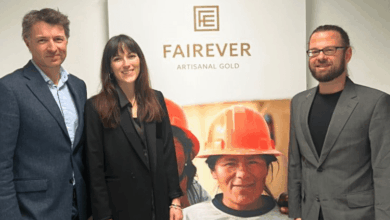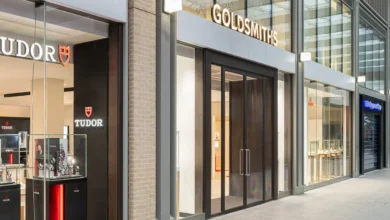REC Watches: Timepieces with a forgotten history

Register to get 1 free article
Reveal the article below by registering for our email newsletter.
Want unlimited access? View Plans
Already have an account? Sign in
Three years ago, REC was conceived following a drunken discussion about Kamstrup and Mygh’s disappointment with the lack of automobile-related timepieces in the industry. Kamstrup says: “There’s nothing new in term of watch brands being inspired by or putting car logos on their products. But we didn’t feel that that was ample justification for what it was supposed to be.”
In their view, the two products were not sufficiently intertwined for a true car enthusiast. Rather than focusing heavily on REC and promoting it as a trademark in its own right, REC puts the focus back on the cars from which the watches are created, centring firmly around passion for the classics. From a marketing standpoint, this is done through video stories detailing the history of the vehicle that each time piece drew its materials from.
Unconventional beginnings only serve the mirror the unconventional faces behind the brand – neither Mygh or Kamstrup are jewellers or indeed have any experience in watch making or designing.
“We had a shopping level of passion for watches and of course what we very quickly discovered is that we knew absolutely nothing at all.” Naturally, as part of their market research, the duo travelled to to Baselworld to identify the competition and see if there were any brands looking seriously at the same concept.
Whilst the founders came across similar brands, they could not find another company doing exactly what they had in mind. From there, they sought manufacturers who would take on the task of turning old cars into watches. “Most of them will run away screaming,” says Kamstrup, “so it took quite a long time to get the full production line sorted out and not without a lot of errors along the way but after a year we finally sorted it out.”
Despite their limited experience, putting themselves into the customers’ shoes and creating a brand of watches that they themselves would wear, meant the duo would ensure they are involved in the design process every step of the way.
Each REC watch begins life as a salvaged car wreck, which is preferably at least 50 or 60 years old. While images of two men rummaging through a car scrap yard may be developing in your mind, there is some method to the search as not all wreckage is good wreckage. “It’s really us looking for – and this sounds odd – the ‘perfect’ car wreck. [That is] a car wreck which has sufficient metal for us to start the recycling process, that material metal is in sufficient condition, it’s not completely rotted away or anything like that,” says Mygh.
The search does not stop there. The REC brand ethos emphasises the story behind the timepieces: the narrative is just as important as the watches themselves. Next, Kamstrup and Mygh go through the history of the car with information obtained from its VIN.
“In a perfect Sherlock Holmes way,” Mygh says, “we start tracking the history of the previous owners: where did they buy it, who did they buy it from, where did they use it, any particular anecdotes or stories that connect to car?” Once the pair has gathered everything of interest from the car, they then proceed to create a video detailing everything they have found. Anyone who goes on to buy the watch created from this car can then find out its backstory, by scanning the accompanying story card on their phones and see how their watch came to be. Depending on how easy it is to find out the car’s history, this process can take anywhere between one and three months.
While the practice of finding the ‘perfect car wreck’ then going through its past with a fine tooth comb may seem tedious, it is rarely unfruitful as the huge market for classic vehicles means there is almost always a rich, and well recorded, backstory. As Kamstrup notes: “A watch to us is not just something that tells you what time it is and sits on your wrist; a car is not just something that gets you from A to B – both objects [evoke] feelings from you.” The brand’s current collections feature watches made from Porsche 911, Ford Mustang and Mini Cooper vehicles.
The car’s classic status is not all that gives the watches a sense of exclusivity; as the pieces are made from salvaged wrecks it is not always possible to make as many watches as the brand may wish, so at times, the ranges are limited edition by default. Depending on the quality of the remaining metal of the car, it can be possible to make as little as a few hundred watches to as many as thousands. “We have a natural limitation; if you imagine a Ford Mustang which is a partly rusted, complete salvage wreck, once we have made 1,000 watches from that there is no more Ford Mustang material left. We would then buy another car and continue producing the same watches but with a different story and a different VIN number on them.”
Not much metal from the cars goes into the watches, as EU regulations ensure that certain materials do not cause any irritation to the customers’ skin. Also, Kamstrup and Mygh try to retain as much of the original metal as possible, as rusty as it may be, so as much of the original vehicle and the sense of wearing a recycled item can remain in the final product. “We would have to melt the metals down in order to produce watch casing. So, much of the pattern and the look and feel of having a recycled item on your wrist would be lost in that process.”
For now, the brand uses the salvaged metal to create just the dials of the watches, with the argument that “dials are the centrepiece for any watch.” Kamstrup explains: “It’s the first thing that will probably catch your eye – it’s definitely one of the central element of any watch design.”
In making use of the body work of a car, he goes on to say: “What we can do is create this experience of seeing something that is visibly unique and visibly has a past of 60 years of usage but is within the watch. So it’s a contrast between a new casing, a new strap and a very rough dial.”
REC has plans to make more use of the cars they recover, as it recently started to incorporate the seat belt into the strap of the car. The remainder of the car either gets donated to local car clubs or the potentially marketable parts like the dashboard are returned to the seller. “They are actually very valuable if you want to restore them.”
Although they have set up their company on the premise of recycling materials that would otherwise be left to rot in junkyards, REC admit that they do not consider themselves to be an ‘environmental’ brand. “Don’t get me wrong, but we are not making these watches to save planet earth or to save the baby seals or anything like this. We have never stated that as an intention of ours. We want to create some really cool watches and that’s more or less it.” However, Kamstrup states that he is quite pleased that their bid to recycle disused material is a welcomed “by product” of their passion for cars and watches.
Despite it not being the stated intention of the brand, it seems that its recycling nature has proved to be popular among its customers, as it has managed to attract a customer based which the founders didn’t expect. “When we originally started out, we made an assumption [that] 90% of all our sales would go to car people that have an affinity for particular cars… but it’s only something like 30 or 40%. The rest of our customer base is just people who appreciate the concept the design, the idea of recycling something that otherwise would’ve been forgotten into something new.”
This has not REC off from trying to immerse themselves deeper into car spaces, as they believe their brand offers something that is relatable to all car lovers which Kamstrup describes as a “niche market”. Quoting a Swedish journalist, he goes on to say: “The only reason a man buys a Rolex is because he can’t bring his Porsche 911 into the bar with him.”
As well as trying to appeal to the car enthusiast market, REC hopes to expand into other vehicles and iconic structures. “There’s no stopping at the cars; it could be U-boats, airplanes, it could be trains, it could be old vinyl records.”
Priding themselves on making products for the lovers of the materials they come from, deciding which vehicle to source next is a collaborative effort between REC and its customers. “We create a shortlist of between three to five different candidates which we believe are feasible. Then we put it online on our website on a poll.”
Considering the brand has only existed for three years and it has not limited itself to classic cars, REC sees many developments in its future. While the brand does not try to lean on the ‘Swiss made’ branding, or pretend to have the highest level of horological accuracy, it hopes to make a move into more mechanical pieces. Introducing watches that have had such features over the last year and a half, REC hopes to build on that through its new collection next year. “Right now our core pieces and mechanical pieces are quite big in our view.”







